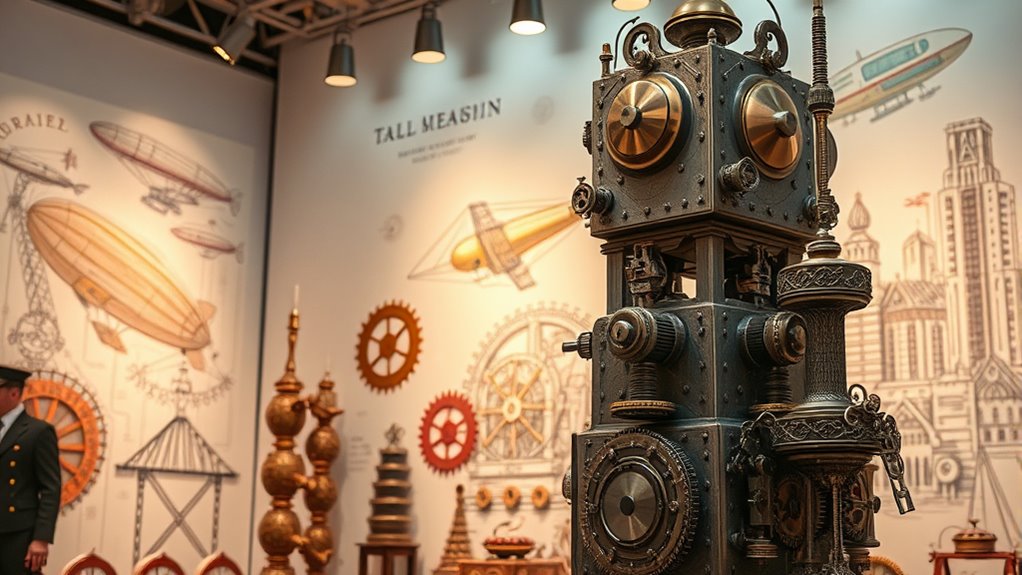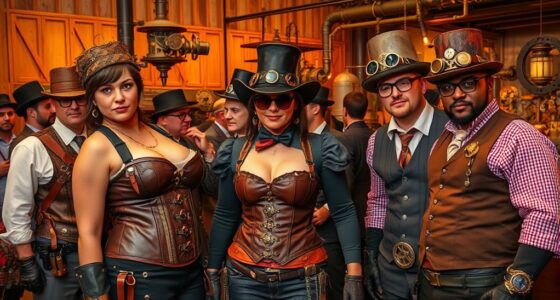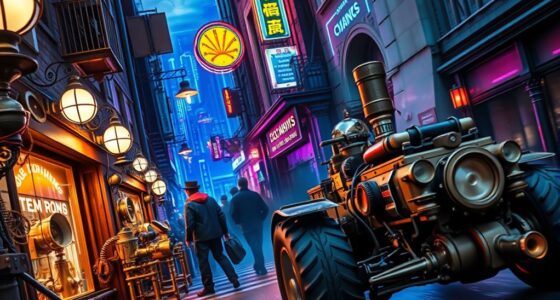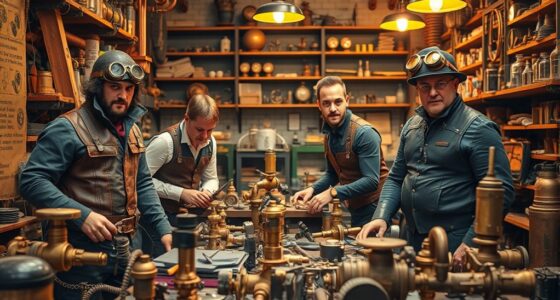Steampunk art blends Victorian elegance with industrial innovation, featuring detailed mechanical motifs in both illustration and sculpture. You’ll see vivid drawings of gear-laden characters and vintage-inspired designs, alongside sculptures made from repurposed metal parts that seem alive with energy. This art form celebrates craftsmanship, imagination, and nostalgia while exploring futuristic themes. If you continue exploring, you’ll uncover how these works combine history and innovation through mesmerizing visuals and skilled craftsmanship.
Key Takeaways
- Steampunk art combines Victorian elegance with futuristic mechanical motifs in both illustrations and sculptures.
- Illustrations highlight detailed line work, shading, and vintage textures to evoke a nostalgic, industrial atmosphere.
- Sculptures utilize repurposed metal parts and gears, creating dynamic, mechanical figures that tell stories of innovation.
- Both art forms emphasize craftsmanship, ornate details, and a blend of history and imagination to inspire wonder.
- Showcasing includes diverse mediums, from vivid drawings to intricate sculptures, illustrating the seamless transition from illustration to sculpture.
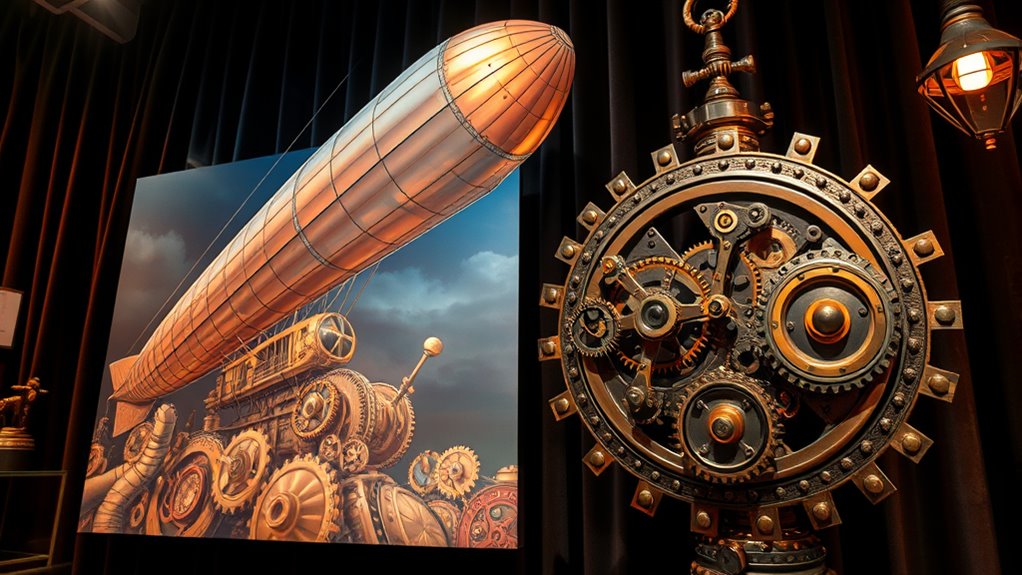
Have you ever wondered how steampunk art beautifully blends Victorian elegance with futuristic innovation? It’s a captivating style that invites you to explore a world where intricate mechanical motifs intertwine with vintage aesthetics. This genre isn’t just about visuals; it’s a way of storytelling that combines history and imagination, creating a universe where gears turn and steam powers the future. When you explore into steampunk art, you notice how every piece is a testament to craftsmanship, blending ornate details with a gritty industrial feel. Whether in illustrations or sculptures, the focus on mechanical motifs — cogs, pistons, and clockwork elements — anchors the aesthetic in a world that values both form and function.
In illustration, steampunk artists harness vivid lines and shading to bring these mechanical motifs to life. You’ll see characters adorned in Victorian-inspired clothing, but with an unmistakable mechanical twist— goggles with layered gears, corsets reinforced with metal plates, or airships with billowing steam engines. These images evoke a sense of adventure and ingenuity, capturing a retro-futuristic spirit that feels both nostalgic and innovative. The vintage aesthetics are central here; they set the tone and atmosphere, making you feel immersed in a bygone era reimagined through a lens of technological wonder. Artists often incorporate sepia tones, intricate patterns, and antique textures to reinforce this vintage vibe, giving the artwork a timeless quality that invites you to imagine a world where the old and new seamlessly coexist. Additionally, mechanical motifs serve as key elements that emphasize the craftsmanship involved in creating these artworks, highlighting the importance of design and engineering in steampunk art.
Steampunk art: Victorian fashion fused with mechanical marvels and vintage charm to ignite imagination and adventure.
When steampunk art moves into sculpture, those same principles take on a tangible form. You might encounter sculptures made from repurposed metal parts, gears, and clock components assembled into figures that seem alive with mechanical energy. These sculptures showcase craftsmanship and creativity, transforming raw industrial materials into art that radiates vintage charm with a modern edge. The mechanical motifs in sculpture are more than decorative—they tell stories of innovation, resilience, and fantasy. As you observe these pieces, you’re drawn into a universe where the boundaries between art and engineering blur, inspiring admiration for the detailed work and the layered symbolism embedded in each creation.
Both illustration and sculpture in steampunk art celebrate the beauty of mechanical motifs and vintage aesthetics, inviting you to step into a world that’s as inventive as it is elegant. They remind you that art can be a bridge between eras—melding Victorian refinement with the bold spirit of futuristic exploration. Whether through detailed drawings or tactile sculptures, steampunk art continuously sparks your imagination, encouraging you to envision a universe powered by steam, gears, and endless possibilities.
Frequently Asked Questions
What Are the Origins of Steampunk Art?
You might wonder about the origins of steampunk art, which blend Victorian influence and industrial aesthetic. This genre emerged in the late 20th century, inspired by science fiction and historical settings. You’ll notice how it combines 19th-century Victorian fashion with machinery and steampunk technology. Its roots lie in literature, but it quickly expanded into visual arts, including illustration and sculpture, celebrating a retro-futuristic vision that’s both nostalgic and innovative.
How Do Artists Choose Materials for Steampunk Sculptures?
Imagine a treasure hunt where Victorian influences guide your hand, leading you to choices that breathe new life into old objects. You pick recycled materials—brass gears, clock parts, leather—to evoke that vintage charm. Your selection depends on durability, aesthetic appeal, and how well each piece captures the steampunk spirit. Ultimately, you craft a sculpture that marries history and innovation, transforming everyday items into fantastical works of art.
Can Steampunk Art Incorporate Modern Technology?
You can definitely incorporate modern technology into steampunk art, blending cyberpunk influence and futuristic adaptations. By integrating LED lights, microcontrollers, or digital components, you add a contemporary twist that complements the vintage aesthetic. This fusion creates a unique piece that bridges past and future. Your creativity shines when you seamlessly combine antique gears with sleek, modern tech, making your steampunk art both innovative and visually compelling.
What Are Common Themes Explored in Steampunk Illustration?
You’re drawn to the whimsical world of steampunk illustration, where common themes often include a blend of Victorian elegance and imaginative innovation. Expect to see aesthetic color palettes that evoke nostalgia, alongside fantastical machinery that sparks curiosity. These artworks explore themes of adventure, exploration, and the clash between tradition and progress, creating a enthralling visual story that invites you into a universe where old-world charm meets futuristic fantasy.
How Can Beginners Start Creating Steampunk Art?
To start creating steampunk art, you should explore mechanical motifs and vintage aesthetics that define the style. Begin by collecting inspiration from old machinery, gears, and Victorian-era designs. Use simple sketches to experiment with combining these elements, then gradually incorporate mixed media or sculpture techniques. Don’t be afraid to experiment and refine your work, as developing your unique steampunk voice takes time and practice.
Conclusion
As you explore steampunk art, remember it’s like stepping into a lively clockwork city—each piece a gear turning in the grand machinery of imagination. I once saw a sculpture that looked like a vintage pocket watch brought to life, reminding me how steampunk blends past and future. Embrace this art form’s creativity, and you’ll find yourself lost in a world where innovation and nostalgia collide, inspiring endless wonder.
